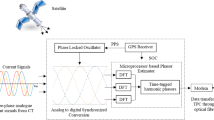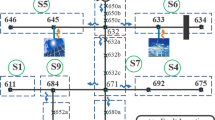Abstract
The problems associated with the stability analysis of power system are very important and has a wide scope of improvement. Severity of the transient disturbances arising in power system are usually studied through critical contingencies simulation. There proper study and assessment is extremely important for a reliable, uninterrupted operation, along with ensuring that no generating unit get desynchronized. The main objective of this research is to develop a fast and robust online transient stability assessment tool to classify the system operating states and to identify system critical generators in case of instability. This research proposes a pipeline machine learning multi-feature hybrid network framework that captures the phasor measurement unit (PMU) measurements and monitor the system transient stability in real-time. The test results verified that our proposed framework is fast and accurate, thereby a viable approach for system stability monitoring applications.




















Similar content being viewed by others
Data Availability
Authors confirm that the data supporting the findings of this study are available within the article.
References
Abbas Q, Celebi ME (2019) Dermodeep-a classification of melanoma-nevus skin lesions using multi-feature fusion of visual features and deep neural network. Multimed Tools Appl 78(16):23559–23580
Abdelgayed TS, Morsi WG, Sidhu TS (2017) Fault detection and classification based on co-training of semisupervised machine learning. IEEE Trans Ind Electron 65(2):1595–1605
Alimi OA, Ouahada K, Abu-Mahfouz AM (2020) A review of machine learning approaches to power system security and stability. IEEE Access 8:113512–113531
Arora S, Bala A (2020) Pap: power aware prediction based framework to reduce disk energy consumption. Clust Comput 23(4):3157–3174
Castillo C, El-Haddad M, Pfeffer J, Stempeck M (2014) Characterizing the life cycle of online news stories using social media reactions. In: Proceedings of the 17th ACM conference on Computer supported cooperative work & social computing. ACM, pp 211–223
Chen C-R, Hsu Y-Y (1991) Synchronous machine steady-state stability analysis using an artificial neural network. IEEE Trans Energy Convers 6(1):12–20
Deo R, Samui P, Roy SS (2020) Predictive modelling for energy management and power systems engineering. Elsevier
Dharmapala KD, Rajapakse A, Narendra K, Zhang Y (2020) Machine learning based real-time monitoring of long-term voltage stability using voltage stability indices. IEEE Access 8:222544–222555
Gao DW, Wang Q, Zhang F, Yang X, Huang Z, Ma S, Li Q, Gong X, Wang F-Y (2019) Application of ai techniques in monitoring and operation of power systems. Frontiers in Energy 13(1):71–85
Geeganage J, Annakkage U, Weekes T, Archer BA (2014) Application of energy-based power system features for dynamic security assessment. IEEE Trans Power Syst 30(4):1957–1965
Geetha R, Ramyadevi K, Balasubramanian M (2021) Prediction of domestic power peak demand and consumption using supervised machine learning with smart meter dataset. Multimed Tools Appl 80(13):19675–19693
Geurts P, Wehenkel L (1998) Early prediction of electric power system blackouts by temporal machine learning. In: Proceedings of the ICML98/AAAI98 workshop on predicting the future: AI approaches to time series analysis, pp 24–26
Gupta A, Gurrala G, Sastry P (2018) An online power system stability monitoring system using convolutional neural networks. IEEE Trans Power Syst 34(2):864–872
Hansen LK, Salamon P (1990) Neural network ensembles. IEEE Transactions on Pattern Analysis & Machine Intelligence 10:993–1001
Hossain E, Khan I, Un-Noor F, Sikander SS, Sunny MSH (2019) Application of big data and machine learning in smart grid, and associated security concerns: a review. Ieee Access 7:13960–13988
Khan A, Li JP, Ahmad N, Sethi S, Haq AU, Patel SH, Rahim S (2020) Predicting emerging trends on social media by modeling it as temporal bipartite networks. IEEE Access 8:39635–39646
Liu R (2018) Power system stability scanning and security assessment using machine learning
Maharjan L, Ditsworth M, Niraula M, Caicedo Narvaez C, Fahimi B (2019) Machine learning based energy management system for grid disaster mitigation. IET Smart Grid 2(2):172–182
Malbasa V, Zheng C, Chen P. -C., Popovic T, Kezunovic M (2017) Voltage stability prediction using active machine learning. IEEE Transactions on Smart Grid 8(6):3117–3124
Miraftabzadeh SM, Foiadelli F, Longo M, Pasetti M (2019) A survey of machine learning applications for power system analytics. In: 2019 IEEE international conference on environment and electrical engineering and 2019 IEEE industrial and commercial power systems europe (EEEIC/I&CPS Europe). IEEE, pp 1–5
Naftel A, Khalid S (2006) Classifying spatiotemporal object trajectories using unsupervised learning in the coefficient feature space. Multimedia Syst 12 (3):227–238
Paital SR, Ray PK, Mohanty A (2018) A review on stability enhancement in smib system using artificial intelligence based techniques. In: 2018 IEEMA engineer infinite conference (eTechNxT). IEEE, pp 1–6
Peiwen L, Yongjing H, Abbas K (2020) Transformers fault prediction: an improved ensembled method. a˜a. 2:1
Sarajcev P, Kunac A, Petrovic G, Despalatovic M (2021) Power system transient stability assessment using stacked autoencoder and voting ensemble. Energies 14(11):3148
Schäfer B., Grabow C, Auer S, Kurths J, Witthaut D, Timme M (2016) Taming instabilities in power grid networks by decentralized control. The European Physical Journal Special Topics 225(3):569–582
Shenoy NK (2015) An approach to assess the resiliency of electric power grids. Ph.D. dissertation, Oklahoma State University
Tan B, Yang J, Pan X, Li J, Xie P, Zeng C (2017) Representational learning approach for power system transient stability assessment based on convolutional neural network. The Journal of Engineering 2017(13):1847–1850
Xu Y, Dai Y, Dong ZY, Zhang R, Meng K (2013) Extreme learning machine-based predictor for real-time frequency stability assessment of electric power systems. Neural Comput Applic 22(3):501–508
Yang Q (2020) Research on power system performance evaluation based on machine learning technology. In: IOP conference series: Materials science and engineering. vol. 782, no. 3. IOP Publishing, p 032011
Yang H, Niu K, Xu D, Xu S (2021) Analysis of power system transient stability characteristics with the application of massive transient stability simulation data. Energy Rep 7:111–117
Zhang Y, Cai W, Wang W, Zhang Y (2017) Stopping criterion for active learning with model stability. ACM Transactions on Intelligent Systems and Technology (TIST) 9(2):1–26
Zhang Y, Li T, Na G, Li G, Li Y (2015) Optimized extreme learning machine for power system transient stability prediction using synchrophasors. Mathematical Problems in Engineering, 2015
Zhou Y, Zhang P (2021) Noise-resilient quantum machine learning for stability assessment of power systems. arXiv:2104.04855
Acknowledgements
This work supported by ”Key Laboratory of Wavelet Active Media Technology” with the National Natural Science Foundation of China (Grant No. 61370073), the National High Technology Research and Development Program of China (Grant No. 2007AA01Z423), Room No: B1301, School of Computer Science, University of Electronic Science and Technology of China (UESTC), No. 2006, Xiyuan Avenue, West Hi-Tech Zone, Chengdu, Sichuan, 611731, P. R. China.
Author information
Authors and Affiliations
Contributions
In research articles, all authors contributed equally.
Corresponding author
Ethics declarations
Conflict of Interests
The authors declaring there is no conflict of interest.
Additional information
Publisher’s note
Springer Nature remains neutral with regard to jurisdictional claims in published maps and institutional affiliations.
Appendix
Rights and permissions
Springer Nature or its licensor (e.g. a society or other partner) holds exclusive rights to this article under a publishing agreement with the author(s) or other rightsholder(s); author self-archiving of the accepted manuscript version of this article is solely governed by the terms of such publishing agreement and applicable law.
About this article
Cite this article
Khan, A., Li, J.P. & Husain, M.A. Power grid stability analysis using pipeline machine. Multimed Tools Appl 82, 25651–25675 (2023). https://doi.org/10.1007/s11042-023-14384-3
Received:
Revised:
Accepted:
Published:
Issue Date:
DOI: https://doi.org/10.1007/s11042-023-14384-3




